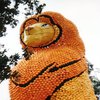Bringing back the Sparkle – Designing Adventure Isle
In one of our previous articles, we defined what makes the Disney Parks and Resorts so special. They offer Guests experiences that appeal to the imagination of many but that are beyond reach of most and to an extent in which Guests are totally immersed into that experience. In order to create an immerse experience, the Walt Disney Imagineers pull all stops. Huge sets, astonishing special effects and a majestic soundtrack contribute to a great experience. But the magic is all in the details! Details add that little extra … the sparkle!
Over the years, Disneyland Paris wasn’t able to keep every aspect of its Parks and Hotels in good working order. At the occasion of its 25th anniversary, the Disneyland Park and hotel area are now getting a major overhaul to bring back the sparkle.

In the upcoming months, 'Designing Disney' will discuss the design of the places that were recently brought back to their original splendor. We sincerely hope that our articles will enable you to enjoy those places the way they were envisioned in the late eighties. In the first installment of our “Bring back the Sparkle” series, retired Walt Disney Imagineer, mister Chris Tietz (Show Producer Adventureland, Disneyland Paris) tells us about the design of Adventure Isle (lovingly refurbished from January until September 2016).

Adventure Isle incorporates elements from several classic Disneyland attractions and vistas such as “The Swiss Family Robinson Treehouse”, “Tom Sawyer Island”, “Captain Hook’s Pirate Ship” and “Skull Rock” (with expanded and enhanced parts of each) and creates the centerpiece of Adventureland.



The south side of the island is dedicated to telling the story of the Swiss Family Robinson. As their treehouse stands high above, the visual focal point of the land, deep below it lay a complex system of caves and tunnels to explore.



Openings on the south, west and north pathways offer five different ways into the subterranean caves which all interconnect and converge on the central “Root Cellar”. So named because here the Robinsons keep their perishable foods and supplies in a cool, dark and secure storage area. Giant roots from the treehouse above create a “root” maze with spooky insect sounds all around and a ceiling hole with views up into the tree itself.






Suspension and floating barrel bridges (elements from Tom Sawyer Island) lead to the north side of the island, where “Captain Hook’s Pirate Ship” and “Skull Rock” watch over entrances to a honeycomb of caves and tunnels themed to the 1883 literary masterpiece “Treasure Island”. Here too are five different ways into and out of a more complex series of tunnels, on two levels, to find the hidden pirate treasure cache.





We pass by the skeletal remains of pirates left behind so that they could not divulge its location, after all, “Dead Men Tell No Tales”. Another route goes past the “Bottomless Pit” and over bridges taking us between waterfalls with a brief glimpse to the outside world. Back into the caverns we must traverse the “Stalagmite Maze” to finally reach the “Pirate Throne” and Ben Gunn’s Treasure scene where another pirate skeleton has died trying to own it.





The "Pirate Throne" is a large chair sculpted out of the rock with skulls all around where guests can sit on for photos. It is located just a little in front of the "Treasure Scene" and to its left. The "Bottomless Pit" can be reached if you take the "Davy Jones's Locker" cave entrance and go immediately to your left. The wooden walkways are slightly slanted towards the pit to give you a little vertigo.
To give the illusion of a never-ending maze of different caves, the tunnels often run parallel with one another, but out of sight to the other. This maximizes the use of the space and creates the feeling of different experiences. Paths and steps take guests in different directions and create different viewpoints and scenes.
The selection of props is minimal, but are reflective of the story. The Robinson’s “Root Cellar” is made up of mostly food items and other perishables. The pirate props are basically skeletons and a pile of doubloons, jewels, and various other valuables.



The names of the caves and tunnels are a play on words in keeping with the pirate theme. “Ambush Alley” was borrowed from “Ambush Rock” on Tom Sawyer Island as was the “Bottomless Pit”. Some names were from Peter Pan such as “Cannon Ball Cove”, “Skull Rock” and “Hook’s Hideout”. Character names were used from Treasure Island like “Ben Gunn’s Cave” and other classic tales like “Davy Jones’s Locker”.


The exterior rockwork was given a specific directional look. On the very south side of the island the rock formations start out relatively horizontal and begin to slant upward as they near the north pirate side. Rising up they create the high point where the "Suspension Bridge" is anchored. The rock stratification is more pronounced on the north side. They fan out in two different directions away from "Skull Rock" and get more vertical as they move to a collision which sets them in an upright formation creating "Spyglass Hill Lookout" and the other high end of the "Suspension Bridge". The rockwork was also given an ocean and wind eroded look. According to the background story, the ocean erosion is what would have formed interior voids and grottos creating the caves and tunnels. This was all a conscious effort to give geological sense to the formation of the island.

This article was written by retired Walt Disney Imagineer, mister Chris Tietz (Show Producer Adventureland, Disneyland Paris). It is part of our “Designing Adventureland” and “Bringing back the Sparkle” (commemorating the 25th anniversary of Disneyland Paris) series.
We would like to express our sincere thanks and appreciation to mister Tietz for the tremendous effort he made in writing this article. The magic of Adventure Isle reawakened our sense of exploration and made us dream about faraway places!









